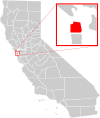Western Addition, San Francisco
Coordinates: 37°46′57″N 122°25′42″W / 37.78250°N 122.42833°W
Western Addition | |
|---|---|
Neighborhood of San Francisco | |
 A southern view from Alta Plaza Park, which is in the Pacific Heights neighborhood. Most of the valley in the central part of this image is in the Western Addition neighborhood. | |
 Western Addition Location within Central San Francisco | |
| Coordinates: 37°46′57″N 122°25′42″W / 37.782472°N 122.428315°W | |
| Country | United States |
| State | California |
| Government | |
| • Supervisor | Dean Preston |
| • State Assembly | Vacant and Phil Ting (D)[1] |
| • State Senator | Scott Wiener (D)[1] |
| • U. S. Rep. | Nancy Pelosi (D)[2] |
| Area | |
| • Total | 0.463 sq mi (1.20 km2) |
| • Land | 0.463 sq mi (1.20 km2) |
| Population (2008)[3] | |
| • Total | 12,934 |
| • Density | 27,919/sq mi (10,780/km2) |
| ZIP Code | 94102, 94109, 94115, 94117 |
| Area codes | 415/628 |
| [3] | |
The Western Addition is a district in San Francisco, California, United States.
Location[]
The Western Addition is located between Van Ness Avenue, the Richmond District, the Haight-Ashbury and Lower Haight neighborhoods, and Pacific Heights.
Today, the term Western Addition is generally used in two ways: to denote either the development's original geographic area or the eastern portion of the neighborhood (also called the Fillmore District) that was redeveloped in the 1950s.
Those who use the term in the former sense generally consider its boundaries to be Van Ness Avenue on the east, Masonic on the west, California Street on the north, and Fell or Oak Street on the south. From there, it is usually divided into smaller neighborhoods such as Lower Pacific Heights, Cathedral Hill, Japantown, the Fillmore, Hayes Valley, Alamo Square, Anza Vista, and North Panhandle.
The San Francisco Association of Realtors defines the term more closely to the latter sense, treating it as "District 6D" (not to be confused with Board of Supervisors districts; much of the Western Addition is in supervisors District 5), bounded by Geary Boulevard in the north, McAllister and Fulton streets, and Golden Gate Avenue on the south, Van Ness Avenue in the east, and Divisadero Street on the west. By this definition, the Western Addition is roughly synonymous with the Fillmore and Cathedral Hill neighborhoods.[4]
History[]
Historically, the Western Addition was first platted during the 1850s as a result of the Van Ness Ordinance. This large tract encompassed some 500 blocks running west from Larkin Street (the city's previous western boundary) to Divisadero Street, (hence the name "Western Addition") creating Jefferson Square, Hamilton Square, Alamo Square, Alta Plaza, and Lafayette Square. The area was initially used for small-scale farming; but, following the invention of the cable car during the 1870s, the Western Addition developed as a Victorian streetcar suburb. It survived the 1906 San Francisco earthquake with its Victorian-style buildings largely intact.
After the Second World War, the Western Addition — particularly the Fillmore District — became a population base and a cultural center for San Francisco's African-American community, a consequence of opportune housing supply due to the internment of Japanese Americans.[5] Since then, urban renewal schemes[6] and San Francisco's changing demographics have led to major changes in the economic and ethnic makeup of the neighborhood, as the Fillmore District suffered from crime[7][8][9] and poverty while many other districts underwent significant gentrification. The Central Freeway used to run through the neighborhood to Turk Street, but that section of the freeway was closed immediately after the 1989 Loma Prieta earthquake and later demolished.
Since the early 1990s, the Western Addition has undergone significant gentrification.[10][11]
Government and infrastructure[]
The San Francisco Police Department Northern Station serves the Western Addition.[12]
See also[]
- Fillmore District
References[]
- ^ a b "Statewide Database". UC Regents. Retrieved December 8, 2014.
- ^ "California's 12th Congressional District - Representatives & District Map". Civic Impulse, LLC.
- ^ a b c "Western Addition neighborhood in San Francisco, California (CA), 94102, 94109, 94115, 94117 subdivision profile - real estate, apartments, condos, homes, community, population, jobs, income, streets". www.city-data.com.
- ^ "propertiessanfrancisco.com - propertiessanfrancisco Resources and Information". www.propertiessanfrancisco.com.
- ^ Barton, Stephen E. (1985). "The Neighborhood Movement in San Francisco". Berkeley Planning Journal. 2 (1). doi:10.5070/BP32113201. ISSN 1047-5192.
- ^ "Jerry Mandel (1960) | UC Berkeley Sociology Department". sociology.berkeley.edu. Retrieved 2019-11-11.
- ^ Turner, Wallace; Times, Special To the New York (1981-07-30). "San Francisco Tackling 'Den of Thieves' Project". The New York Times. ISSN 0362-4331. Retrieved 2019-11-11.
- ^ Gordon, Rachel; August 5, Chronicle Staff Writer | on; 2005 (2005-08-05). "SAN FRANCISCO / Western Addition deadliest city area / 3rd slaying in 8 days prompts response from police, mayor". www.sfgate.com. Retrieved 2019-11-11.CS1 maint: numeric names: authors list (link)
- ^ August 14, Jaxon Van Derbeken | on; 1999 (1999-08-14). "Bloodshed in Alamo Square / Drug dealers, thugs plague picturesque S.F. neighborhood". www.sfgate.com. Retrieved 2019-11-11.CS1 maint: numeric names: authors list (link)
- ^ Cherney, Max (2015-02-08). "San Francisco: Where Violent Street Gangs and Silicon Valley Tech Bros Coexist". Vice. Retrieved 2019-11-11.
- ^ Blake, Shaquina (March 5, 2016). "In Their Words: Growing Up in Old Fillmore". Hoodline. Archived from the original on February 5, 2017.
- ^ "Northern Station." (Archive) San Francisco Police Department. Retrieved on September 1, 2013.
External links[]
| Wikimedia Commons has media related to Western Addition, San Francisco. |
 San_Francisco/Western Addition travel guide from Wikivoyage
San_Francisco/Western Addition travel guide from Wikivoyage
- Western Addition, San Francisco
- Neighborhoods in San Francisco

